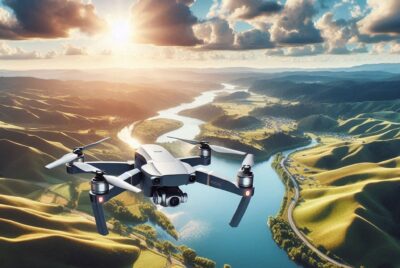Underwater Drones: Exploring the Deep
*We may earn a commission for purchases made using our links. Please see our disclosure to learn more.
Underwater Drones: Exploring the Depths of Oceanic Innovation
Exploring the oceans has always been a fascinating venture, aiming to uncover the mysteries that lie beneath the waves. Technology has taken us from bulky submersibles to sophisticated underwater drones, capable of probing the depths with unprecedented flexibility and detail. Underwater drones, or remotely operated vehicles (ROVs), represent a significant leap in marine technology, offering a window into the ocean’s hidden realms for scientists, filmmakers, enthusiasts, and even treasure hunters.
These subaquatic machines come equipped with cameras, sensors, and sometimes robotic arms to navigate underwater landscapes, record videos, or even collect samples. They are used for a multitude of tasks, including inspection of submerged structures, observation of marine wildlife, and mapping of the ocean floor. Their capability to reach areas that are too dangerous or inaccessible for humans makes them invaluable tools for oceanographic research and conservation efforts.
When considering an underwater drone, durability, depth capability, battery life, ease of control, and the quality of the onboard camera system are crucial. You’ll want to select a drone that can withstand the pressure of the depths it will explore, with enough battery life to accomplish its mission, and controls that are responsive and user-friendly to ensure a productive dive. Moreover, the camera should offer high resolution and good low-light performance to capture clear images or video in the often dim underwater environment.
After carefully examining various models, assessing their build, performance in a range of underwater conditions, and the clarity of their photographic output, I’ve narrowed down a selection of underwater drones that stand out in the market. These choices cater to a broad spectrum of needs, from casual exploration to professional-grade underwater filming.
Top Underwater Drones
I’ve carefully curated a list of the top underwater drones that are poised to enhance your underwater exploration and photography. With state-of-the-art cameras and unparalleled maneuverability, these drones provide an immersive experience of the aquatic world. Whether you’re a professional filmmaker, a marine researcher, or an enthusiast looking to capture stunning underwater footage, you will find the perfect drone that fits your needs and budget in the following roundup.
FIFISH V-EVO
If you’re seeking a high-tech companion for your underwater explorations, the FIFISH V-EVO is a contender with its cutting-edge features and robust controls.
Pros
- Impressively smooth 4K 60FPS video capture
- Superior mobility and intuitive controls with VR capabilities
- Bright LED lighting enhances underwater visibility
Cons
- Learning curve may be steep for beginners
- Price point may be prohibitive for casual users
- Bulkier design compared to some other models
I recently had the chance to take the FIFISH V-EVO for a dive, and the 4K 60FPS camera truly makes your underwater footage look professional. This drone’s fluid motion and the capability to hover with precision provided me with some stunning shots. The AI Vision Lock is a game-changer, keeping the subject in focus without the hassle of manual adjustments.
The 360° mobility is another aspect where the V-EVO shines. I could easily maneuver in all directions, something not all underwater drones offer. The added VR control had me completely absorbed in the experience, controlling the drone’s movement by simply tilting my head.
Something that took me by surprise was the intensity of the 5000 lumens LED lights. Even in murkier waters, visibility was exceptionally clear, revealing underwater details that would otherwise remain hidden in shadows. However, I did notice that handling the V-EVO takes some practice, and it might initially be a bit challenging for someone new to underwater drones. Another point to consider is the drone’s price and size – it’s an investment in both money and space.
From my recent dive, the FIFISH V-EVO stands out as a robust underwater drone packed with advanced features. Its performance in capturing and illuminating the underwater world is nothing short of remarkable, making it a powerful tool for both professionals and serious enthusiasts.
Chasing Gladius Mini
Exploring underwater vistas with the Chasing Gladius Mini redefines marine exploration with its ease of use and crisp imaging.
Pros
- User-friendly controls akin to gaming
- High-quality 4K UHD camera for clear underwater footage
- Impressively light and portable for on-the-go adventurers
Cons
- Incomplete delivery set has been reported
- Connectivity issues with the app on some devices
- Stability challenges in strong underwater currents
From the moment I handled the Gladius Mini, I was struck by how its lightweight design hardly weighed down my bag. Despite its small size, it was a breeze to navigate underwater, cutting through currents with a responsive agility that made me feel in complete command.
The 4K UHD camera didn’t disappoint either. My underwater footage sparkled with clarity, turning each dive into a cinematic experience. The twin LED lights scattered the shadows, revealing the mysteries of the deep in vibrant detail to my eager eyes.
However, it wasn’t all smooth sailing. During setup, I noticed the absence of the promised backpack and freshwater ballast. Also, a couple of attempts to sync the app on different devices resulted in a frustrating black screen. These were kinks in an otherwise well-crafted machine.
In essence, the Gladius Mini is a capable companion for your underwater quests, provided you’re prepared for possible hiccups with app connectivity and package contents. Its portability and user-friendly interface make it an accessible tool for any ocean enthusiast.
Chasing Mini S
I recommend the Chasing Mini S for enthusiasts looking to explore underwater environments with extended runtime and a stable 4K camera, though be mindful of customer service experiences.
Pros
- Extended battery life allows for longer dive times
- 4K camera with EIS offers clear underwater footage
- Enhanced movement range boosts exploration capabilities
Cons
- Some users reported issues with customer support
- May require additional weights for freshwater usage
- Wired remote connection can be limiting for some users
Capturing the serene beauty of underwater realms has been a captivating experience with the Chasing Mini S. Its prolonged battery life not only allowed me to enjoy prolonged explorations, but the ease of setup made every dive seamless. The unit’s impressive speed and maneuverability let me navigate effortlessly through aquatic landscapes.
Seeing marine life through the lens of this drone’s camera was nothing short of stunning. The built-in anti-shake feature coupled with the 4K resolution delivered crystal-clear visuals, ensuring every moment was recorded with precision. The ability to add on items like robotic arms meant even more interaction with the underwater environment.
However, not everything was smooth sailing. While the enhanced runtime was a boon, I did encounter the limitation of having to use a wired remote connection, which feels a step back in today’s wireless world. Additionally, I would advise potential buyers to be prepared for the possibility of less-than-ideal customer service based on multiple feedback points, which could be crucial when in need of assistance.
Buying Guide
When I consider purchasing an underwater drone, I assess several key features to ensure I choose the best product for my needs. These features inform my decision-making process.
Purpose and Usage
To start, I define my purpose for the drone. Whether it’s for professional marine research, underwater photography, or recreational exploration, the intended use significantly influences the features I prioritize.
Operating Depth
The maximum operating depth is crucial; I ensure the drone I select can safely reach and operate at the depths required for my activities.
Battery Life
I evaluate battery life, as this determines how long the drone can operate before needing a recharge. Longer battery life equates to extended use underwater, which is beneficial for longer missions.
Camera Quality
Camera quality is paramount for clear, high-resolution images and video. I look for drones with cameras that offer high megapixel ratings and reliable stabilization features for the best visual output.
Specifications to Consider:
| Feature | Importance |
| Operating Depth | Must match my required depth range |
| Battery Life | Preferably long for extended use |
| Camera Resolution | High for crystal-clear captures |
| Control Range | Sufficient to maintain control |
| Portability | Compact and light for easy transport |
Connectivity and Control
The drone’s control range and connectivity options, such as Wi-Fi or cable, dictate how freely I can maneuver it underwater. A broad control range is especially important in open waters.
Build and Durability
Considering the underwater environment is harsh, I look for a well-built drone with sturdy materials that can withstand the pressure and possible collisions. Durability ensures longevity and safeguards my investment.
By keeping these features in mind, I select an underwater drone that is reliable, functional, and suitable for my intended underwater activities.
Frequently Asked Questions
In this section, I provide clear answers to common inquiries regarding underwater drones, focusing on their functionalities, utilization, pricing, market options, and operational depths.
1. What are the capabilities of military-grade underwater drones?
Military-grade underwater drones are designed for robustness and advanced capabilities, including deep-sea exploration, mine countermeasures, surveillance, and intelligence gathering. These drones are often equipped with sonar systems, high-resolution cameras, and autonomous navigation technologies to perform in challenging marine environments.
2. How are underwater drones equipped with cameras utilized?
Underwater drones with cameras serve various purposes such as marine biology research, underwater infrastructure inspection, and videography. They capture high-quality images and videos, offering real-time feedback to operators, providing valuable data for scientific studies or maintenance assessments of subsea structures.
3. What factors determine the pricing of underwater drones?
The pricing of underwater drones is influenced by factors such as depth rating, autonomy features, camera quality, build materials, and onboard technology like sonar and navigational systems. Specialized software capabilities and additional functionality like robotic arms also contribute to the cost.
4. Which are the best underwater drones available on the market?
Some of the leading underwater drones include the Blue Robotics BlueROV2, which is known for its modularity, and the Gladius Mini, popular for its user-friendliness and 4K camera. The Trident Underwater Drone is celebrated for its agility and ease of use, making these models among the best choices for various underwater activities.
5. What depths can consumer underwater drones typically reach?
Consumer underwater drones are typically rated for depths ranging from 30 to 500 meters, depending on their design and target market. Recreational models commonly have shallower depth capabilities, while advanced ones used for research or professional videography may reach the higher end of this spectrum.







